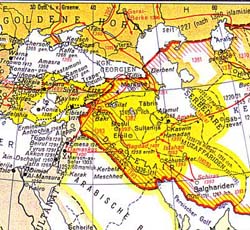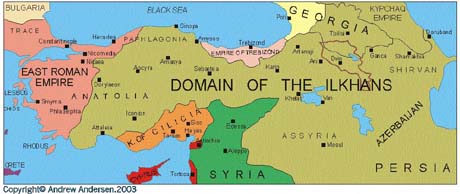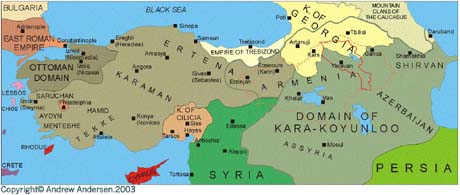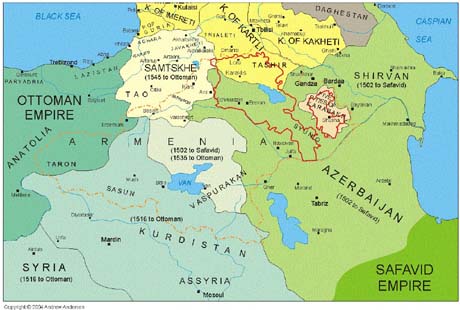Armenia
Falling to the
Mongols, Turks and Persians 1235 - 1535
 In
the second quarter of the 13th century the South Caucasus
and Asia Minor faced the invasion of the Mongols. By the
year 1250, most of the area fell to the Mongols including
Georgia, all Armenian lands of the South Caucasus and
Central Anatolia. In
the second quarter of the 13th century the South Caucasus
and Asia Minor faced the invasion of the Mongols. By the
year 1250, most of the area fell to the Mongols including
Georgia, all Armenian lands of the South Caucasus and
Central Anatolia.
The Mongol rule was
accompanied by devastation of the land, destruction, mass
murder and extremely high tribute imposed on the population.
Armed resistance and uprisings were put down with extreme
cruelty. Cilicia happened to be the only Armenian-inhabited
country that managed to withstand Mongol conquest.
Cilicia and Other Armenian
Lands in the Aftermath of the Mongol Invasion (1236 - 45)
and the Restauration of East Roman Empire (1261)

 |
Mongol Conquests
by 1245 |
 |
Byzantine (E.
Roman) Empire after 1261 |
 |
Crusader States
by 1265 |
 |
Domain of
Egyptian Mamlyuks |
 |
Venetian
Possesions |
 |
Armenian Kingdom
in Cilicia |
 |
Modern Armenia |
By 1337 the Mongol
domination collapsed, however the Mongols were succeeded by
various Turkic invaders. Most of the Old Armenian
lands fell under Kara-Koyunloo and later Aq-Koyunloo. Other
areas of Armenia and Anatolia were incorporated into other
Turkic domains. The Kingdom of Cilicia desperately fighting
against the Turks and Arabs, lost most of its eastern
provinces to the Turks by 1335. In 1375 the remainder of
once prosperous kingdom was conquered by the Mamlyuks of
Egypt.
 In
1392-1404 all Armenian lands faced Turco-Mongolic invasions
under the leadership of Tamerlane that happened top be the
most devastating cataclysm in the last 300 years. Armenian,
Georgian and Greek cities and towns of the area were ruined,
Many thousands of Armenians were slaughtered. Many more
thousands flee to Western and Eastern Europe as well as
Africa and Asia. In
1392-1404 all Armenian lands faced Turco-Mongolic invasions
under the leadership of Tamerlane that happened top be the
most devastating cataclysm in the last 300 years. Armenian,
Georgian and Greek cities and towns of the area were ruined,
Many thousands of Armenians were slaughtered. Many more
thousands flee to Western and Eastern Europe as well as
Africa and Asia.
The death of Tamerlane in 1405
resulted in almost immediate fall of his empire. After that,
Ottoman Turks and Egyptian Mamlyuks became the two dominant
powers in the Middle East turning the area into Turco-Arab
realm.
By the middle of the 15th century,
West European Crusaders completely lost the 350 years-long
battle for Palestine and Syria and were forced to evacuate
all their possessions except Cyprus and other Mediterranean
islands.
By the same time,
East Roman Empire lost all her possessions except the
capital city of Constantinople and some other smaller
enclaves. In 1453 Constantinople fell to the Ottoman Turks
becoming Istanbul, the capital of the strongest, rapidly
expanding Muslim empire and ending East Roman era.
Cilicia and Other
Armenian Lands Between 1340 and 1453:
Beginning of
Ottoman Expansion, Brief Rise of Georgia (1340-1385), The
Loss of Cilicia (1375), Tamerlane Invasions (1385-1405) and
the Fall of East Roman Empire (1453)

 |
Ottoman Territory
by 1340 |
 |
Kara-Koyunloo
Domain 1340-1385 & 1406-1453 |
 |
Other Turcic
Domains by 1265 |
 |
Domain of
Egyptian Mamlucs by 1359 |
 |
Re-United Georgia
1340-1385 &1405-1453 |
 |
Armenian Kingdom
in Cilicia 1335-1375 Conquered by the Mamluks in
1375 |
 |
Byzantine (E.
Roman) Empyre 1340-1365 |
 |
N-Western Limits
of Tamerlane Empire |
 |
Ottoman Conquests
1361-1452 |
 |
Byzantine Empire
1361-1452, Conquered by the Ottomans in 1453 |
 |
Venetian
Possesions |
 |
Genoese Possesion |
 |
Crusader States |
 |
Historical
Armenia Under Turcic & Georgian Rule |
 |
Modern Armenia |
By the middle of the
15th century, most of the Armenian feudal aristocracy
was already destroyed, their lands taken by Turkoman,
Tatar and even Kurdish nomadic military nobility. Thus
the Armenian Apostolic Church remained the only major
force cementing Armenian people and keeping them apart
from the new conquerors and settlers from Central Asia.
The transfer of the throne of Catholicos of all
Armenians to Echmiadzin (near Yerevan) in 1441 enhanced
the importance of the Ararat valley and the city of
Yerevan as the new center of the Armenian lands.
By 1516, the expanding Ottomans put
all Western Armenia under their control. 14 years earlier,
Eastern Armenia fell to Shah Ismail who was the founder of
the Azeri Safavid dynasty that turnedIran into a new
Islamic power of the area. The Safavid-Ottoman wars of 1514
– 1535 resulted in border changes as a result of which more
Armenian lands were incorporated into the Ottoman Empire.
Several Armenian
provinces remained for a while parts of Georgia that was in
process of feudal fragmentation. The Armenian-inhabited
province of Tashir was part of the Georgian Kingdom of
Kartli. Smaller provinces of Kars, Karnipor and Valashkert
were parts of the Atabaghty of Samtskhe (Southern Georgia)
until the year of 1545 when Samtskhe was absorbed by the
Ottomans. The only remaining relict of Armenian statehood
was for some time surviving in the mountains of Artsakh
(Karabakh) where five tiny Armenian princely states
(Dgheraberd, Dizak, Gyulistan, Khachen and Varanda) managed
to keep their independence until the late 18th century.
16th Century: Partition
of Armenian Lands Between Ottoman Turkey
and Safavid Iran

 |
Historical
Armenian Territory with Heavy Armenian Presence in
the 16th Century |
 |
Ottoman Empire by
1515 |
 |
Safavid Empire by
1499 |
 |
Georgian Feudal
States by 1634 |
 |
Five
Principalites of Karabakh, the Last Relict of
Armenian Statehood |
 |
Ottoman Conquest
in the 1st Quarter of the 16th Century |
 |
Safavid Conquests
in 1500 |
 |
Georgian Losses
to the Ottomans in 1635 |
 |
Modern Armenia &
Karabakh |
 |
Ottoman Conquests
in the 2nd Quarter of the 16th Century |
 |
Safavid Losses in
1535 |
Copyright © 1996-2005
Atlas of Conflicts, Andrew Andersen. All rights reserved. |

